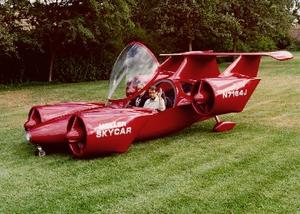Flying carDARPA-funded new engine brings flying car closer
DARPA awards Pratt & Whitney Rocketdyne a $1 million contract to develop its EnduroCORE engine, which the company says offers “a high power-to-weight ratio comparable to gas turbines”; the engine will bring the Transformer TX flying car closer to reality

The VTOL Moller Skycar M400 // Source: howstuffworks.com
Interesting news on the flying-car front. A Californian space-rocket company says it has received U.S. government funding to develop a novel engine that would offer as much power-for-weight as a gas turbine, but would be much cheaper and simpler to make and maintain.
Pratt & Whitney Rocketdyne announced the $1 million contract award on Tuesday. The company says that its EnduroCORE engine offers “a high power-to-weight ratio comparable to gas turbines.” This is not an expensive-to-run engine like a regular aviation turbojet or turboshaft as seen in today’s planes and choppers, however. This is “a durable, lightweight, high-performance diesel engine … mechanically simple for reliability,” which has “demonstrated quiet operation in testing.”
Lewis Page writes that this fulfills many of the needs of flying cars. It is powerful enough, potentially, for vertical-takeoff and hovering, yet it is simple and reliable like a diesel. It is quiet, too.
The EnduroCORE deal is intended to provide the power plant for the Transformer TX project (“DARPA unveils details of Transformer TX flying car,” 14 April 2010 HSNW). The project is intended to produce a four-seater flying jeep/Humvee-style machine able to drive off road on the ground or lift off vertically and fly about under the control of a human operator (one without more training than it takes to get an ordinary driving license). This flying jeeps would be used by U.S. Marine units too small to have their own attached helicopters.
The design of the TX is yet to be settled. It might be a re-designed gyrocraft jump-copter, or an alternative ducted-fan-in-wing design from Lockheed (details of which are not available; but see discussion in “New counter-IED approach: flying car,” 9 July 2010 HSNW). Page notes that it now appears that whichever design is chosen, the power plant is likely to be an EnduroCORE engine rather than a high-maintenance turbine.
Page contacted Scott Claflin, Rocketdyne, who is in chare of “Power Innovations” at Rocketdyne, to find out some more.
According to Claflin, the EnduroCORE is neither a regular piston diesel, nor yet a turbocharged job. He describes it as “a novel type of rotary engine” that can run on any heavy fuel — military JP-8 or regular diesel are both fine. He confirms the claims made in the company’s press release, saying that EnduroCORE “will have an installed power-to-weight similar to gas turbine engines.”
Claflin would not offer further specifics, saying that the EnduroCORE technology is a proprietary company secret — and in any case, it counts as valuable military technology and so is subject to U.S. war technology-control laws.
Page writes that if all that Rocketdyne says is true, this is important news not just for the U.S. Marines but for flying cars more generally. Many obstacles to making flying cars a reality have been removed: modern automated controls and satellite navigation mean that it is now relatively easy to make light aircraft that can take off, fly about, land themselves and even interface with air-traffic control systems without human input.
Clever airframe designs notwithstanding, for a proper vertical-takeoff flying car, some innovative power plant — with the power of a turbine but without the cost and hassle and noise — is a necessity. Now, according to Rocketdyne, such a power plant is here. This would also mean a lot of other improvements — better generators, better ground cars, better conventional aircraft. The most radical departure this power plant would allow, though, would be a flying car.
Page notes, though, that there are a couple of caveats. Firstly, Rocketdyne specifies that “high rotating speeds” are required to get maximum power from EnduroCORE. This is a hint that some burdens associated with turbines may still exist — the need for complicated and trouble-prone gearboxes as in today’s helicopters, for instance, or high-speed bearings and so forth in the engine itself. “Doubtless, an EnduroCORE-powered U.S. Marine hoverjeep would be cheaper to run than a helicopter, but it probably won’t be as cheap as an ordinary Humvee,” Page notes.
Still, “the EnduroCORE deal is promising sign for us flying-car hopefuls,” Page concludes.
